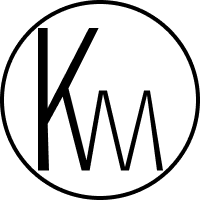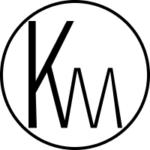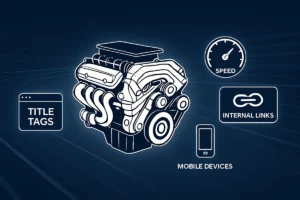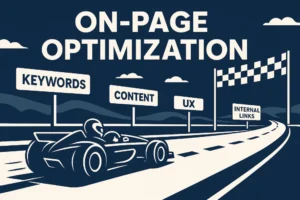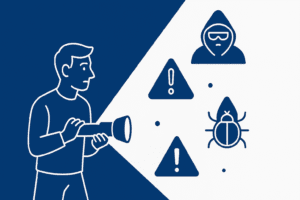🚀 On-Page SEO Strategies in 60 Seconds: What Actually Moves Rankings
(Read this first — deep dive on On-Page SEO Strategies after it)
Most on-page SEO strategies advice online is fluff. Let’s cut it. If you only have a minute, here’s what’s worth your energy:
- Speed > Everything → A 2-second load beats a 5-second one, even if you have perfect keywords.
- Titles That Earn Clicks → Not just stuffed keywords. Power words + clarity = higher CTR.
- Meta Descriptions That Sell → They don’t directly rank, but they decide if you get the click.
- Headers That Guide & Rank → Every H2 is a mini-headline for skimmers and Google.
- Internal Links That Keep Readers Hooked → Your site is a web, not a line.
Now, On to the Introduction…
When it comes to climbing the search results, your foundation isn’t backlinks or ads. The foundation is the work you do on your own site. That’s where on-page SEO strategies come in. Think of them as the tune-up under the hood: the precise adjustments to content, structure, and user experience that tell both Google and your audience, “this page deserves to be here.”
Done right, on-page SEO is more than a checklist. It’s a deliberate system for aligning your page with search intent, improving readability, and making every element (titles, headers, images, internal links) pull its weight. The payoff? Higher rankings, more qualified traffic, and a site that feels effortless to navigate.
But here’s the catch: search algorithms and user behavior aren’t standing still. The tactics that worked five years ago won’t work today. Things like keyword stuffing, endless meta tweaks don’t cut it anymore. Today’s winners use a mix of timeless fundamentals (like clean URLs and fast load times) and forward-looking tactics (like featured snippet optimization and AI-ready formatting).
This guide breaks down the on-page SEO strategies that actually move the needle in 2025. These steps are practical, proven, and sequenced for maximum impact. Whether you’re publishing your first blog or scaling a massive site, these are the levers worth pulling.
Want this done for you instead of learning it the hard way? At Katmantra Web Designs, we don’t just “check the boxes” on on-page SEO strategies— we make your pages rank higher, load faster, and convert better. From keyword strategy to technical clean-up, we handle it all so you can focus on running your business. Our clients see measurable gains in traffic and leads because we do SEO like it’s 2025, not 2015. Ready to see what your site can really do?
What Makes a Real “Strategy” (vs. Just Doing Optimization)
Imagine you’re preparing for a Formula 1 race. “Optimization” is making sure the car’s tires are inflated, the fuel tank is full, and the mirrors are adjusted. In SEO terms, that’s fixing technical issues, cleaning up metadata, improving load speed, and ensuring headings are in order. All necessary, but all baseline.
“Strategy,” on the other hand, is deciding when to pit stop, how to overtake on tricky turns, and which rival to pressure for position. For on-page SEO, that means knowing which levers to pull first based on your page’s goals, your audience’s search intent, and your competitors’ weaknesses.
The best on-page SEO strategies are deliberate, measurable, and sequenced for impact:
- First Phase: Close the biggest content gaps against your top 3 organic competitors.
- Second Phase: Optimize supporting signals (internal links, schema, FAQs).
- Third Phase: Refresh and expand content for secondary terms once the main rankings stabilize.
For a deep dive into the differences, check out our article on On-page vs Off-page SEO
Before touching a single meta tag, run a content gap analysis against your top 3 competitors. This ensures your efforts are aimed at surpassing actual rivals, not just following generic best practices.
Treating “publish and pray” as a strategy. Hitting update without a measurement plan is like throwing darts blindfolded. You might hit the board, but you’ll never know why.
Ranking Factor Priorities—What to Tackle First
When you strip away all the noise, a handful of on-page SEO strategies moves consistently drive the biggest wins. These five stand out:
1. Intent-Driven, Unique Content
Create pages that speak directly to the searcher’s intent (not just the keyword) win both the click and the dwell time. We’ve seen rankings jump for a client simply by rewriting posts to answer reader pain points instead of recycling generic info.
2. Keyword Placement in Key Spots
Titles, headers, and the first 100 words are prime real estate. This helps search engines instantly understand relevance and reassures readers they’re in the right place. Shifting a target keyword into the opening line alone has pushed sites up entire SERP rows.
3. Fast, Mobile-Friendly Load Times
If your page drags, users bounce. Google notices this. On one site, cutting load time from 4.5s to 1.8s doubled session duration and nudged three primary pages into the top 5.
4. Logical Internal Linking to Power Pages
Strategic linking funnels both authority and readers to the content that matters most. A sales page’s traffic climbed 37% in a month when it was added to relevant blog link paths. Clean, evergreen URLs amplify this effect long-term, so avoid messy structures that invite redirects later.
5. Compelling Meta for Higher CTR
Even a page in the #5 spot can outperform #2 if its title and description promise something irresistible. We’ve seen CTR lifts of 40%+ just by rewriting meta to hit emotional triggers.
These aren’t random tweaks. These are deliberate levers, ranked for maximum return. Nail these first before chasing smaller optimizations.
Don’t try to “fix everything” at once. Audit your top 10 traffic-driving pages first! Small wins compound faster when you sharpen what already ranks. Example: tightening the intro + adding an FAQ schema block on one page often beats rewriting 20 forgotten posts.
The fastest SEO wins come from sharpening what already performs. Again, start with your top 10 traffic pages, not the dusty backlog. A focused 1,200-word guide that nails search intent will outrank a 3,000-word fluff monster every time. The mistake most people make? Chasing word count instead of clarity. Trim, tighten, and optimize high-traffic pages first, then expand. That’s how small tweaks compound into big lifts.
On-Page SEO strategies #1: Create Intent-Focused, Not Just Keyword-Focused, Content
Google’s algorithms look for more than just keyword matches. It measures how well your content fulfills the searcher’s intent. That means your page should give readers exactly what they came for, plus something extra they didn’t even know they needed.
What to Do:
- Identify the primary intent (informational, navigational, transactional) behind your target keyword.
- Layer in “information gain” by including unique insights, data, examples, or perspectives that aren’t already dominating the SERPs.
- Use advanced formats. Use tables, infographics, comparison charts, step-by-step visuals to present information in more digestible, valuable ways.
- Showcase expertise signals: cite credible sources, add author bios with credentials, and link to deeper resources.
Why It Works:
Pages that align perfectly with intent satisfy both the user and Google’s Quality Rater Guidelines. The result? Better engagement metrics (longer time on page, lower bounce rate) and stronger trust signals. Both of these influence rankings.
How to Apply It:
- Search your target keyword and analyze the top-ranking pages. Note the common themes and the gaps.
- Build your outline around closing those gaps while preserving what’s already working in the SERP.
- Write as if you’re answering the reader’s exact question in a conversation, not just filling space for a keyword quota.
Google’s “information gain” patents reward content that adds something new to the conversation. Before you draft, ask yourself: What’s the one chart, dataset, or example I can bring in that nobody else has? That single differentiator can tip rankings in your favor even against bigger domains.
Trying to force every possible intent into one bloated page. They trying to cram FAQs, product promos, and a mini-Wikipedia entry into the same article. That confuses both the reader and Google. Focus on the primary intent first and only layer extras if they naturally support it.
On-Page SEO strategies #2: Keyword Placement for Context & Relevance
Search engines rely on more than keyword presence. They read where those keywords appear to understand the page’s context and authority. Strategic placement signals relevance without resorting to outdated “keyword stuffing” tactics.
What to Do:
- Title Tag: Place the primary keyword as close to the beginning as possible while keeping it natural.
- H1 Heading: Match or closely mirror the title for strong topical alignment.
- Opening Paragraph: Include the keyword (or a close variation) within the first 100 words to confirm the topic early.
- Subheadings (H2/H3): Sprinkle variations or semantic keywords to reinforce coverage.
- URL: Keep it short, clean, and include the primary keyword (e.g., /on-page-seo-guide).
- Image Alt Text: Describe images using relevant keywords naturally to aid accessibility and image search.
There’s no fixed “ideal keyword density.” Instead, focus on coverage. Ensure the keyword and related terms appear where they help clarify meaning, and semantic fit, so they blend naturally with the surrounding content.
Either hiding the main keyword too deep or stuffing it everywhere. Skipping easy wins like subheadings, alt text, or clean URLs also weakens relevance. Keep it natural, not forced.
Why It Works:
This approach helps Google and other search engines map your page to the correct search intent, while also improving user experience by keeping content clear, organized, and easy to scan.
How to Apply It:
- Identify your primary keyword and 2–3 close variations.
- Integrate them into high-priority spots without breaking the reading flow.
- Review your draft to confirm keywords feel natural and aren’t overused.
On-Page SEO strategies #3: Compelling, Keyworded Title Tag
Your title tag is the first thing both search engines and potential visitors see. It’s your prime real estate for grabbing attention and signaling relevance. A well-crafted, keyword-rich title can drastically improve click-through rates while reinforcing topic authority.
What to Do:
- Include the Primary Keyword Early: Ideally within the first few words, while keeping it natural.
- Add Modifiers: Words like “Best,” “Guide,” “Checklist,” “Fast,” or “Proven” can make titles more enticing.
- Evoke Emotion or Curiosity: Subtle emotional cues (“Effective,” “Essential,” “Secret”) often increase clicks.
- Refresh with Timeliness: Add the current year or other freshness indicators when appropriate (e.g., “2025 On-Page SEO Guide”).
- Stay Within 50–60 Characters: Prevents truncation in search results while leaving enough room for impact.
Why It Works:
Title tags directly influence rankings and CTR. Search engines use them as a primary relevance signal, while users often decide to click based solely on the title’s appeal.
How to Apply It:
- Identify your page’s main keyword.
- Draft 3–5 variations combining keyword, modifier, and emotional trigger.
- Test character count—aim for under 60 characters without losing clarity.
- Choose the version that best balances keyword presence and user appeal.
When drafting variations, front-load the keyword but experiment with swapping modifiers and emotional triggers. Sometimes “Proven SEO Guide” outperforms “Best SEO Guide,” even if both are technically correct. Small tweaks can swing CTR big.
Forcing too many keywords makes titles robotic, while skipping modifiers or emotional hooks leaves them bland. Going over 60 characters risks truncation, but cutting too short often loses context. Balance is everything.
On-Page SEO strategies #4: Click-Worthy (But Honest) Meta Description
Think of your meta description as a 30-second elevator pitch for your page. It’s not a ranking factor directly, but it heavily influences whether people click. A great meta description acts like ad copy: it grabs attention, matches the searcher’s intent, and promises a clear benefit without overhyping.
What to Do:
- Write for Humans, Not Just Bots: Make it engaging, conversational, and benefit-driven.
- Match the Search Intent: If someone’s looking for a “how-to,” promise clear steps; if it’s a product, emphasize the value or outcome.
- Include the Target Keyword Naturally: It’ll appear in bold in SERPs when matching the search query.
- Offer a Compelling Hook: Use curiosity, urgency, or a unique selling point to stand out.
- Keep It Concise: Stay within 150–160 characters to avoid truncation.
Why It Works:
Even if your page ranks well, a boring or mismatched meta description can tank CTR. On the other hand, an accurate and appealing one can make your listing more clickable than higher-ranked competitors.
How to Apply It:
- Identify the primary search intent for the page.
- Write a one-sentence value proposition + one-sentence supporting detail.
- Naturally work the target keyword into the text.
- Compare with competing SERP entries and refine until yours feels irresistible but truthful.
Treat meta descriptions like mini-ads. Lead with the benefit, slip in the keyword naturally, and finish with a subtle hook that makes the user need to click. Test phrasing like “Discover how…” vs. “Learn the secrets to…”. The smallest change can flip CTR.
Stuffing with keywords (looks spammy), writing bland summaries (“This article is about SEO”), or overhyping with clickbait promises you can’t deliver. Also, going over 160 characters means Google chops it off mid-sentence; instant trust killer!
On-Page SEO strategies #5: Semantic and Hierarchical Header Structure
Your Headers are road signs for both readers and search engines and not just a way to make text look pretty. A well-structured header hierarchy improves readability, strengthens topical relevance, and sets you up for featured snippets or AI summaries.
What to Do:
- Use a Single H1: This is your page’s main headline, usually matching (or complementing) your title tag.
- Organize with H2, H3, H4: Break your content into logical “chunks,” each covering a subtopic. Use H2 for main sections, H3 for subsections, and H4 for finer details.
- Keyword Integration: Naturally work in your target keyword or semantic variations within headers to reinforce context.
- Use FAQ and How-To Headers: These not only improve scannability but also increase your chances of earning featured snippets and AI/LLM citations.
- Maintain Flow: Headers should guide the reader logically from one idea to the next and avoid scattering unrelated topics.
Why It Works:
Google uses headers to understand the hierarchy and meaning of your content, which boosts relevance scoring. For readers, a clean header structure makes scanning effortless, keeping bounce rates lower.
How to Apply It:
- Outline your page topics before writing.
- Assign each major point an H2, then break them down into H3s/H4s as needed.
- Keep headers descriptive, not vague (“5 Ways to Reduce Bounce Rate” is better than “Tips”).
- Add FAQ-style and step-by-step headers where it fits naturally.
- Review your header flow for logical progression before publishing.
Draft your headers before writing the body. Think of them as the “chapter titles” of your page. If someone read only the headers, they should still grasp the flow and main points. This makes your writing sharper and boosts your odds of ranking for multiple long-tail queries.
These confuse Google and breaks both flow and SEO value – Multiple H1s. Dropping vague headers like “Introduction” or “Conclusion”. Stuffing every header with the exact same keyword. Skipping logical order (jumping from H2 straight to H5). Scattering FAQs randomly instead of nesting them where they fit.
On-Page SEO strategies #6: Short, Keyword-Rich, Consistent URLs
Your URL is one of the first things both users and search engines see, so make it clean, meaningful, and easy to remember. A well-structured URL can subtly improve rankings and CTR by signaling relevance and professionalism.
What to Do:
- Keep It Short: Aim for 3–5 words. Keep it long enough to include the primary keyword but short enough to be easily typed or remembered.
- Include the Main Keyword: Place your target keyword toward the front for maximum visibility in search snippets.
- Use Hyphens, Not Underscores: Hyphens are Google’s preferred word separator.
- Avoid Junk: Strip out dates, session IDs, numbers, or irrelevant words that add no value.
- Stay Consistent: Apply the same structure site-wide for a cohesive look and easier maintenance.
Why It Works:
Short, descriptive URLs improve click-through rates by instantly telling the searcher what the page is about. They also help search engines quickly assess page relevance, improving crawl efficiency and indexation.
How to Apply It:
- Choose your primary keyword before creating the page.
- Remove stop words (like “and,” “of,” “the”) unless essential for clarity.
- Use lowercase letters only to avoid duplicate URL issues.
- Review for readability. If you can’t guess the page’s topic from the URL alone, simplify it.
- Once set, avoid changing URLs unless absolutely necessary, and always set up 301 redirects when you do.
Plan your URL slugs at the same time you finalize your keyword strategy. Treat them like a “headline in miniature” – short, memorable, and keyword-forward. If your content calendar is mapped, pre-draft the URLs before writing to keep consistency across the whole site.
Letting auto-generated URLs live (full of dates, numbers, or “/category/1234”), overstuffing keywords (e.g., /seo-seo-seo-guide), using mixed case (/MyPage/SEO/), or constantly changing slugs after publishing. These tank trust, create redirect chains, and confuse both users and Google.
On-Page SEO strategies #6: Internal Linking to Boost Power Pages
Internal linking isn’t just about navigation. it’s your in-house SEO power grid. By strategically linking to your most valuable “power pages” (those that drive traffic, leads, or revenue), you can direct PageRank and relevance signals exactly where you want them.
What to Do:
- Identify Power Pages: These might be your top-ranking articles, cornerstone content, or high-converting sales pages.
- Use Contextual Anchors: Instead of generic “click here,” use descriptive anchor text that naturally includes relevant keywords.
- Link From Related Content: Add links within body copy where it makes logical sense to the reader.
- Sculpt PageRank: Prioritize outbound links to key pages from high-authority internal pages (e.g., homepage, popular blogs).
- Limit Overlinking: Too many links dilute impact. Be intentional.
Why It Works:
Google uses internal links to understand your site’s structure and content relationships. By pointing more internal links to a page, you signal its importance, boosting its authority and helping it rank faster. Contextual anchors also add semantic relevance, which can improve keyword targeting without stuffing.
How to Apply It:
- Audit your site to find pages with high authority but low strategic linking.
- Select 2–4 related, high-priority pages to link from each new article.
- Place links where readers naturally need more detail or next steps.
- Review quarterly to adjust linking as rankings shift.
- Keep it human. Your links should guide users, not just algorithms.
Make internal linking part of your publishing ritual. Every new piece should feed 2–4 “power pages” with contextual links. Build it into your workflow so links are intentional, not an afterthought.
Don’t dump links in footers or sidebars. Google values body context more. Avoid stuffing the same keyword anchor everywhere, or drowning paragraphs in links. And never leave pages orphaned. If it’s worth publishing, it’s worth linking to.
On-Page SEO strategies #7: External Linking to Authoritative Sources
External linking is often underestimated, but it’s a subtle trust signal both to users and search engines. Linking out to high-authority, contextually relevant sources shows that your content is well-researched, connected to the wider web, and not operating in an echo chamber.
What to Do:
- Choose Authoritative Sources: Link to .edu, .gov, recognized industry leaders, or established news outlets in your niche.
- Ensure Contextual Fit: The link should directly support or expand on a claim, stat, or definition in your content.
- Open in a New Tab: Keep users on your site while giving them the option to explore more.
- Cite Data Properly: Whenever you use a stat or fact, link to its original source, not a random blog repeating it.
Why It Works:
Google evaluates topical authority; your site’s perceived expertise in its niche. By linking to reputable sources, you essentially “borrow” trust and signal that your content is part of an authoritative network. Users are also more likely to trust your insights when you transparently show where your information comes from.
How to Apply It:
- Audit your content for claims, definitions, or statistics that would benefit from a reference.
- Identify the most reputable and relevant original source for that piece of information.
- Link using descriptive anchor text (e.g., “research from Stanford University”; not “click here”).
- Keep external links balanced. Too many can distract from your own authority.
- Periodically check and replace broken or outdated links.
External links aren’t exits; they’re endorsements. Point only to the gold standard: primary data, industry leaders, or official sources. Each link is a quiet “vote” that strengthens your authority while giving readers confidence.
Don’t link to competitors or low-quality blogs parroting the same stat. Avoid using “click here” as anchor text, or dumping too many outbound links that bleed focus. Worst of all, never leave broken links hanging; they kill trust instantly.
On-Page SEO strategies #8: Visual Content & Image SEO
Images do more than make your content look pretty. Images carry SEO weight when optimized correctly. Google indexes images, and well-optimized visuals can bring traffic from both search results and image search while enhancing on-page engagement.
What to Do:
- Descriptive File Names: Name your images based on their content and target keyword (e.g., on-page-optimization-checklist.png instead of IMG1234.png).
- Thoughtful Alt Text: Write alt text that describes the image naturally while incorporating relevant keywords. This helps accessibility and search relevance.
- Image Compression: Use tools like TinyPNG, Squoosh, or WebP format to reduce file size without losing quality, boosts speed and Core Web Vitals.
- Lazy Loading: Load images only when they’re about to appear in the viewport to improve page load times.
Why It Works:
Optimized images improve page speed, accessibility, and user experience. Google considers all these factors in rankings. Plus, well-keyworded images can rank in Google Images, bringing an extra traffic stream.
How to Apply It:
- Audit current images for size, file naming, and alt text.
- Rename and re-upload large or poorly named images.
- Add descriptive alt text that matches the image’s purpose and context.
- Enable lazy loading in your CMS or with a plugin (e.g., in WordPress: loading=”lazy”).
- Use compressed formats (WebP, AVIF) wherever possible.
Treat every image like its own mini SEO asset. A clean file name + sharp alt text = free ranking real estate. Bonus: optimize images once, and they’ll quietly pull in clicks for years through Google Images.
Don’t upload 5MB photos straight from your DSLR. Avoid stuffing alt text with keywords. It reads spammy and wrecks accessibility. Steer clear of generic names like “banner-final-v3.png.” And never skip compression! Heavy images kill speed (and rankings).
On-Page SEO strategies #9: Page Experience (Speed, Mobile, Core Web Vitals)
Page experience isn’t just a “nice to have”. Google has confirmed it’s a ranking signal, and users won’t stick around if your site feels slow or clunky. Speed, mobile usability, and Core Web Vitals are the trifecta that decide whether people engage or bounce.
What to Do:
- Speed Optimization: Compress images, minify CSS/JS, use caching/CDNs, and remove unused scripts.
- Mobile Responsiveness: Use responsive layouts, legible font sizes, and tap-friendly buttons.
- Core Web Vitals: Track and improve Largest Contentful Paint (LCP), Cumulative Layout Shift (CLS), and First Input Delay (FID) using tools like PageSpeed Insights or Lighthouse.
Why It Works:
A smooth, fast, mobile-friendly site keeps users engaged and signals to search engines that your site is trustworthy and worth ranking higher. Google rewards websites that deliver a seamless experience across devices.
How to Apply It:
- Audit your site with PageSpeed Insights and Lighthouse.
- Prioritize fixes that impact LCP, CLS, and FID.
- Test responsiveness on multiple devices and browsers.
- Implement a CDN and lazy loading for media-heavy pages.
- Re-test regularly to maintain performance as you add new content.
Focus on perceived speed, not just lab scores. A page that feels instant to users (fast first paint, stable layout, smooth scrolling) wins trust, even if Lighthouse still nags you about minor scripts.
Don’t chase a perfect 100 PageSpeed score at the expense of design. Avoid bloated themes, oversized hero sliders, or intrusive popups that wreck mobile usability. Ignoring mobile testing is a killer. Things that look fine on desktop often break on smaller screens.
On-Page SEO strategies #10: Be Featured Snippet and AI/LLM-Ready
Getting your content featured in Google’s Position Zero or easily parsed by AI tools can massively boost visibility. Featured snippets (and now AI-generated overviews) often pull concise, high-value answers from well-structured content. If you optimize for them, you’re playing directly in the space where modern search happens.
What to Do:
- Use Answer-Based Headers: Write headers in question form (“What is On-Page Optimization?”) so search engines can map them to common queries.
- Give Concise Definitions First: Immediately after the header, provide a direct, 1–2 sentence answer before expanding into detail.
- Leverage Lists & Tables: Break down steps, comparisons, or key points into bulleted or numbered lists.
- Structured Data Markup: Use schema types (FAQPage, HowTo, Article) to help search engines recognize answer formats.
Why It Works:
Search engines and AI models prefer structured, scannable content with clear answers. By formatting your content to deliver those answers upfront, you increase your odds of being quoted, summarized, or highlighted in both SERPs and AI responses.
How to Apply It:
- Identify target snippet opportunities with keyword tools that track “People Also Ask” and featured snippet SERPs.
- Rework existing content sections to start with a crisp definition, followed by elaboration.
- Format procedural content into short, ordered steps.
- Use schema markup to signal context.
- Monitor snippet capture and adjust formats to what’s winning in your niche.
Write like you’re answering a curious friend’s question over coffee. Give only what is needed – beginning, middle, end, plot, details, condense. Tell it!!! That conversational clarity is exactly what snippets and AI models pull.
Don’t bury definitions deep in paragraphs. Google ain’t gonna dig for them. Skipping schema is another big miss; without structured data, your content is harder for algorithms to interpret. And resist over-stuffing headers with keywords. Keep them natural and question-based.
Strategies in Action—Mini-Case Examples
Think small changes can’t move the needle? These real-world wins prove that a single title tweak, a smarter link structure, or a content-UX tune-up can spark massive jumps in clicks, rankings, and conversions.
Real-world data beats theory every time. Here are four quick-hit examples showing how smart, focused on-page SEO tweaks translate into serious results.
1. Recipe Schema Delivers Massive Growth for Food Blogger
Kristin Porter of the gluten-free food blog Iowa Girl Eats added recipe and review schema markup plus optimized images. This move won the blog more recipe snippets and placements in Google’s “recipe carousel,” as well as higher ranks in image search, driving the site to 1.5 million monthly visits in under three months.
Source see “Iowa Girl Eats” case study
2. Loyalty Platform AwardWallet Grows Organic Clicks by 46% with Content SEO
AwardWallet, a B2B SaaS for tracking loyalty rewards, shifted to search-intent driven blogging and optimized existing content with on-page keyword integration and technical clean-up. They focused on aligning content with what searchers actually wanted, consolidated overlapping posts, and followed on-page best practices. The result: 2.92 million organic clicks over 12 months and a 46% year-over-year traffic increase.
Source: see AwardWallet case study
3. Wall Street Oasis: Forum Optimizes 200,000+ Pages for Indexing and Quality
Wall Street Oasis, a massive career forum in finance, faced stalled growth and poor indexation after Google algorithm updates. To recover, they removed or improved thousands of thin, low-value user-generated threads and overhauled on-page signals on their best-performing pages. After these changes, they saw a 32% boost in organic search traffic, breaking out of a multi-year growth plateau.
Source: Wall Street Oasis Case Study
4. Redditors Self-Report On-Page SEO Wins
SEO practitioners on Reddit’s r/SEO community share real-world effects of on-page improvements. Examples include improved rankings and visibility after optimizing content for user intent (not just keywords), enhancing header tags and internal linking, compressing images for faster page speed, and boosting Core Web Vitals. Users reported measurable upticks in search positions and engagement after even basic, user-driven on-page updates.
Source: Redditors report on SEO wins
Why This Matters:
These case studies aren’t just “feel good” wins—they show that even small, precise changes in on-page SEO can deliver disproportionate results. From rewriting a title tag to restructuring internal links, or pairing a content refresh with UX improvements, each tactic here directly connects to the core strategies in this guide. The takeaway? On-page SEO isn’t a one-time setup. On-page SEO is a continuous refinement process where every element is an opportunity to boost visibility, clicks, and conversions.
Quick Wins vs. Ongoing Processes
Not every on-page SEO tactic lives on your calendar forever. Some are “set it once and forget it” fixes—others demand regular attention if you want rankings to stick and grow.
Quick Wins (One-and-Done)
- URL Structure – Decide on short, keyword-rich, consistent URLs before publishing. Once live, changing them risks broken links and lost equity.
- Initial Title & Meta Setup – Get these right during creation, then tweak only if data shows underperformance.
- Mobile-Friendly Design – A responsive template or layout overhaul is a foundational job—you won’t need to redo it unless you redesign.
Ongoing Processes
- Content Refreshes – Update stats, examples, and trends every few months to keep pages competitive.
- Internal Linking Audits – New content opens new linking opportunities; review quarterly.
- Image & Media Optimization – As you add content, keep compression, alt text, and load time in check.
- Performance Tracking & CTR Tests – Titles and metas can be A/B tested continuously for incremental gains.
Suggested 30/60/90-Day Roadmap
Day 0–30:
- Audit existing pages for quick wins—fix URLs, titles, metas, and mobile issues.
- Remove thin or duplicate content.
Day 31–60:
- Build and execute a refresh plan for underperforming but high-potential pages.
- Start structured internal linking improvements.
Day 61–90:
- Launch ongoing monitoring cycles: quarterly content updates, link audits, CTR tests.
- Layer in advanced tactics like featured snippet targeting and multimedia SEO.
Common Pitfalls and Misunderstandings
Even seasoned marketers can tank on-page performance by following outdated advice or misinterpreting best practices. Here are the heavy hitters—and how to fix them before they hurt your rankings.
On-Page SEO strategies Mistake #1: Optimizing for Keyword Density, Not Intent
The problem: Chasing a “magic number” of keyword appearances often produces clunky, overstuffed content that reads like it was written for bots, not humans.
Bad example:
“Our organic coffee beans are the best organic coffee beans for people who love organic coffee beans.”
Good example:
“Our organic coffee beans are grown in high-altitude farms and roasted in small batches for a richer, more nuanced flavor.”
Fix this, not that: Stop counting keywords. Start covering all the questions and subtopics a searcher has on the subject. Use related phrases and synonyms to signal relevance.
On-Page SEO strategies Mistake #2: Ignoring Hierarchy in Headers
The problem: Using multiple H1s or skipping heading levels breaks content flow for both users and search engines.
Bad example:
- H1: “Best Laptops”
- H3: “Battery Life” (without an H2 category above it)
Good example:
- H1: “Best Laptops for Designers in 2025”
- H2: “Performance & Graphics”
- H3: “Battery Life for Long Workdays”
Fix this, not that: Follow a logical outline—H1 once, then cascade down with H2, H3, H4. Think of it like nesting folders: each subtopic should live under the right “parent” heading.
On-Page SEO strategies Mistake #3: Treating Internal Links Like Afterthoughts
The problem: Throwing random “related” links into content without context leads to wasted link equity and lower click-through rates.
Bad example:
“Check our other article.” (link to homepage)
Good example:
“See our full breakdown of ‘mobile-friendly website design tips’ (this part links to an article on the same) to boost engagement on smartphones.”
Fix this, not that: Use descriptive, keyword-rich anchor text that fits the sentence naturally. Link to specific, relevant pages that help the reader go deeper.
On-Page SEO strategies Mistake #4: Forgetting Page Experience Is an On-Page Factor
The problem: A slow, clunky page that looks great on desktop but collapses on mobile will tank rankings. Yes, it will, even if the content is perfect.
Bad example:
- 8MB hero image loading before main content.
- Buttons too small to tap on mobile.
Good example:
- Compressed hero image under 200KB.
- Mobile-first design with thumb-friendly buttons and clear CTAs.
Fix this, not that: Regularly check Core Web Vitals in Search Console. Prioritize mobile usability, load speed, and visual stability before adding “nice-to-have” design extras.
Advanced On-Page SEO strategies Tactics for 2025 and Beyond
On-page SEO is no longer just about keywords, headings, and alt text. On-page SEO is about structuring your content so humans, search engines, and AI systems can all parse and reuse it effectively. Here’s how to stay ahead.
On-Page SEO strategies #1: Content Chunking for LLMs and Passage Indexing
Search engines and AI models increasingly pull parts of your content into answers; not just whole pages.
Break your content into clearly labeled, self-contained “chunks” (short sections with descriptive headers, concise definitions, and context-rich paragraphs). This makes it easier for Google to feature your answer directly in a snippet, or for AI tools to surface your content as a credible source.
Quick win: Each H2 or H3 should be able to stand alone and answer a specific question, without needing the rest of the article.
On-Page SEO strategies #2: Schema Markup Beyond the Basics
Structured data isn’t new, but 2025 is about precision.
Add FAQPage and HowTo schema for tutorial-style content. Implement Article, Product, or LocalBusiness schema where relevant. For niche pages, consider Speakable schema to make content discoverable via voice assistants.
Pro move: Combine schema types strategically—e.g., a blog post with FAQ schema for long-tail keyword capture and HowTo schema for step-by-step guides.
On-Page SEO strategies #3: Social Preview Optimization
Platforms like LinkedIn, X (Twitter), and WhatsApp often decide whether your content gets clicks based on your Open Graph and Twitter Card data.
Craft unique, benefit-driven og:title and og:description values, not just your SEO title/meta description, and ensure images meet platform aspect ratios.
Example:
- SEO Title: Best Website Security Scanners for 2025: Complete Guide
- OG Title: Stop Hackers Before They Start – The 2025 Website Security Scanner Guide
On-Page SEO strategies #4: Anticipating “What’s Next”
- AI Summarization Hooks: Add TL;DR sections or “Key Takeaways” lists so AI tools and smart snippets favor your content.
- Multi-Format Content Blocks: Pair text with short, embedded videos, charts, and downloadable PDFs. Google increasingly values pages offering multiple content formats.
- E-E-A-T Signals at Scale: Add real author bios with credentials, source citations, and external references to every major content piece to reinforce authority.
Resources & Tools to help your On-Page SEO strategies (“Toolkit” Sidebar)
When you’re ready to put these strategies into practice, having the right tools on hand makes all the difference. Here’s a quick shortlist of must-haves from our on-page SEO stack—each tested and used in real campaigns.
1. Semrush
A powerhouse for keyword research, competitive analysis, and on-page audits. Great for spotting content gaps and tracking ranking improvements.
2. Ahrefs
Known for its backlink index, but equally strong for identifying keyword opportunities, monitoring content performance, and analyzing SERPs.
3. Screaming Frog SEO Spider
Perfect for crawling your site to find broken links, missing tags, and structural issues that could be quietly harming rankings.
4. Google Search Console (Free)
Direct data from Google. Track impressions, clicks, and indexing status, plus identify keywords you’re already ranking for but haven’t optimized.
5. Google’s Rich Results Test (Free)
Instantly check if your schema markup is valid and preview how your rich snippets might appear in SERPs.
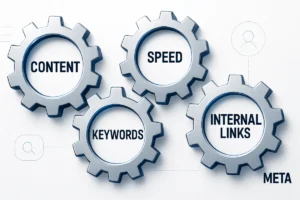
On-page SEO strategies aren’t something you can set and forget — but it also doesn’t have to eat up your time. At Katmantra Web Designs, we run a proven SEO process that gets your site noticed, clicked, and trusted. Whether you need a full audit, a content overhaul, or a technical tune-up, we bring the expertise and tools to get it right the first time. No generic reports. No cookie-cutter fixes. Just work that moves the needle for your rankings and revenue.
Final Thoughts and Action Steps on On-Page SEO strategies
Strategic execution beats checklist behavior, always.
You don’t win rankings by ticking boxes; you win by understanding intent, focusing on the highest-impact moves, and executing them consistently. Start small: pick your top three on-page SEO strategies from this guide. It doesn’t matter if that’s refining title tags, strengthening internal links, or optimizing for Core Web Vitals. Just pick and implement them this week.
Once those are in motion, layer in the rest at a steady, measurable pace. Think of it like building a high-performance car: get the engine running smoothly first, then fine-tune the aerodynamics, paint, and interior.
💡 Your Next Steps
- Choose 3 high-impact on-page SEO strategies from above and apply them within the next 7 days.
- Bookmark this guide for monthly reference.
- Schedule a quarterly review to add the next layer of optimizations.
Remember, SEO isn’t won in theory. SEO is won in the tweaks you make every day. So, pick your three moves, hit publish, and let the rankings chase you.

I design high-performing WordPress + Elementor websites and WooCommerce stores that rank on Google and convert visitors into customers. At Katmantra Web Design and SEO, I combine clean design with smart SEO so your site works as hard as you do.
